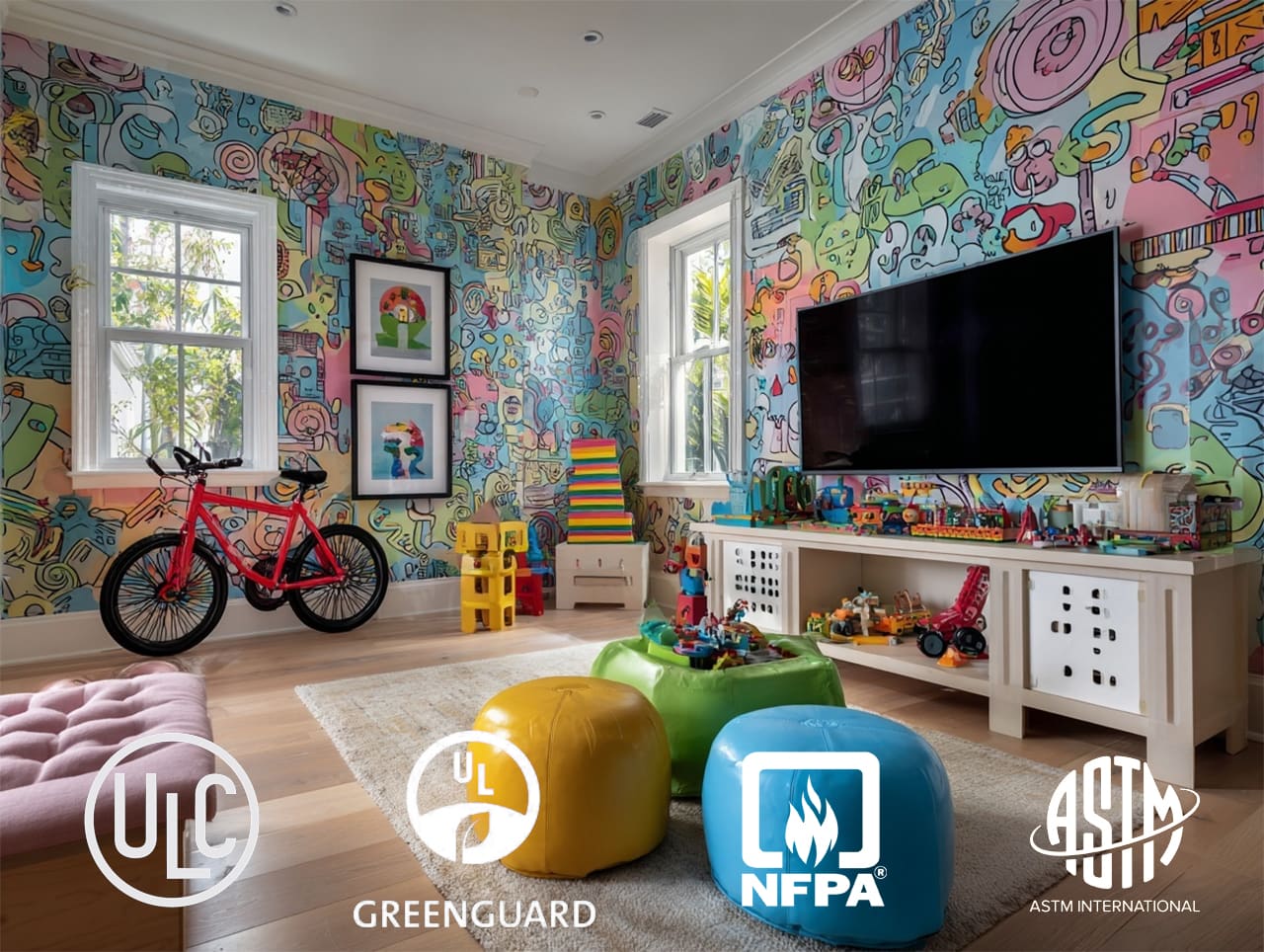Picture this: You’re standing in an empty hospital room, about to transform sterile white walls into something warmer, more human. But wait — this isn’t your living room. The wrong wallpaper choice here could literally make people sick.
Welcome to the surprisingly complex world of safe wallcoverings, where chemistry meets design, and where your aesthetic choices must be tempered by science. Whether you’re designing a nursery for a child or specifying materials for a 500-bed medical center, the stakes are real.
Quick Answer Synopsis
Need wallpaper for a nursery, hospital, or care facility? Look for products with Class A fire ratings, low VOC emissions, and UV-cured inks. These ensure safety without sacrificing style. Commercial-grade Type II wallcoverings offer maximum durability for high-traffic areas, while Type I works for moderate use. Always verify ASTM E84 fire compliance and CDPH air quality standards. UV-cured printing eliminates harmful solvents completely.
What Are VOCs, and Why Should You Care?
Let’s start with the elephant in the room — or rather, the invisible gases in the room. VOCs, or Volatile Organic Compounds, are chemicals that evaporate at room temperature. Think of them as the wallpaper world’s version of secondhand smoke, except you can’t see or smell many of them.
The term “VOC” entered our vocabulary in the 1970s when scientists discovered that new buildings were making people sick. Remember that “new car smell” everyone used to love? Turns out it’s a cocktail of chemicals off-gassing from plastics and adhesives. The same thing happens with wallcoverings, except you’re breathing it 24/7.
The EPA stepped in during the 1980s, followed by California’s aggressive CDPH (California Department of Public Health) standards in the 2000s. Today, organizations like GREENGUARD and the Collaborative for High Performance Schools (CHPS) set the bar for what’s considered safe. Think of them as the FDA of the wallcovering world—except their standards are often stricter.
The UV Revolution: When Light Becomes Your Friend
Traditional wallpaper printing uses solvent-based inks that need to evaporate to dry. It’s like painting with nail polish — the smell tells you something’s escaping into the air. Those escaping solvents? Pure VOCs.
Enter UV-cured inks, the superhero of the printing world. Instead of evaporating to dry, these inks solidify instantly when hit with ultraviolet light. It’s very similar to the how dentists instantly cure and harden modern-day fillings with light. The UV process creates a solid, inert surface with virtually zero emissions.
The magic happens at 395 nanometers — a specific wavelength that triggers instant polymerization. No solvents, no waiting, no smell. For a children’s hospital or senior care facility, this means walls that are safe from day one. There is no need to vent the space or wait weeks for the ink to fully cure. It also eliminates smudging and provides a resilient, scrubbable finish that will hold up for decades.
Understanding Fire Ratings Without a Chemistry Degree
Fire safety ratings read like alphabet soup to the untrained eye: ASTM E84, NFPA 286, CAN/ULC-S102. But here’s what actually matters: Class A means your wallpaper won’t turn into a torch if someone holds a flame to it. It’s the gold standard required in most commercial buildings and anywhere vulnerable populations live or receive care.
The testing itself is highly extensive and thorough. Labs literally set wallpaper on fire in controlled conditions, measuring flame spread and smoke development. A Class A rating means the material performs better than red oak lumber—nature’s baseline for “reasonably safe.”
For context, untreated paper wallpaper can spread flames faster than you can run. Class A wallcovering gives you precious minutes for evacuation. In a nursery or care facility, those minutes save lives.
Choosing the Right Wallpaper: Type I vs. Type II vs. Peel-and-Stick
Without diving too deep (we have a comprehensive guide for that), here’s your quick primer:
Type II is the heavyweight champion—20 ounces per linear yard, built like a tank. Hospitals love it because it can take a beating from gurneys, wheelchairs, and industrial cleaning.
Type I is the middleweight—lighter but still commercial-grade. Perfect for areas that see traffic but not abuse.
Peel-and-stick is the flexible friend—easy to install and remove, ideal for rentals or spaces that change frequently.
Wallpaper Choices in Practice
Let’s get practical. You’re designing a pediatric ward. You need:
- Vivid colors cheerful designs that wont fade
- Durability to withstand toys, markers, and medical equipment
- Cleanability for infection control
- Zero emissions because sick kids have compromised immune systems
Or maybe you’re creating an urgent care unit. Now you need:
- Slip-resistant options for areas where walls meet floors
- Moisture resistance for bathroom areas
- Easy maintenance because staff time is precious
Each environment has its own puzzle to solve. We wrote this article to help demystify the selection process, but for mission critical projects we highly recommend talking to your wallpaper printshop or provider, they will be best equipped to assess your project and connect the necessary wallpaper specs to your project’s unique requirements.
The Dreamscape Difference
Dreamscape wallcoverings meet ASTM G21 mold and mildew resistance standards through 28-day testing at high humidity conditions. This inherent resistance, combined with Class A fire ratings (ASTM E84, NFPA 286, NFPA 265), ensures optimal safety in healthcare settings where infection control remains paramount.
Scrubbability and washability certification (WA-101 standards) enables proper sanitation protocols essential for medical facilities. The textile-backed construction withstands repeated cleaning with healthcare-approved disinfectants while maintaining structural integrity and appearance.
Educational applications benefit from Type II durability ratings that resist impacts from furniture movement, student activities, and maintenance equipment. The non-toxic formulations meet California’s stringent requirements for children’s environments while providing design flexibility for engaging learning spaces.
Installation: Where Good Intentions Meet Reality
Even the safest wallcovering can fail if installed incorrectly. Professional installers certified by the Wallcovering Installers Association (WIA) know the tricks: proper temperature control, adhesive selection, seam treatment.
Environmental conditions require 65-75°F during installation with 24-hour adhesive cure time before topcoat application. Precise measurement and site surveys prevent waste and ensure seamless appearance in large-scale healthcare and educational installations.
Zero-VOC system combinations using compatible adhesives and primers maintain emission-free environments from installation through long-term use. Extended working times with recommended adhesives allow for precise positioning essential in demanding commercial applications.
Compatible adhesives and topcoats maintain zero-emission systems
The following products make excellent
Roman Decorating Products provides optimal adhesive solutions with their Pro 880 Ultra Clear offering 0% VOC content (EPA Method 24) and USDA Certified BioBased formulation. This premium strippable adhesive covers 330 square feet per gallon while promoting easy removal of fabric-backed wallcoverings.
Eco 888 Clear represents the ultimate zero-emission option, featuring CDPH v1.2 compliance and NSF/ANSI 342 certification for sustainable building standards. The adhesive contributes to LEED credits for low-emitting materials while maintaining commercial-grade performance.
DreamGuard ProTex3 protective coating system provides 5x increased abrasion resistance with water-based formulation that maintains breathability. Available in Satin and Matte finishes, this invisible barrier protection preserves wallcovering integrity in high-traffic healthcare and educational environments without altering appearance or contributing emissions.
Real-world applications demonstrate proven performance
Healthcare facilities benefit from Dreamscape’s impact resistance against medical equipment while maintaining decontamination compatibility with hospital-grade cleaning protocols. Emergency departments particularly value the combination of durability, cleanability, and air quality performance.
Educational environments leverage Type II durability for high-traffic corridors while utilizing lighter Type I products in classrooms and administrative areas. Zero-VOC formulations provide particular value in early childhood education settings where air quality concerns remain heightened.
Senior living facilities increasingly specify Terralon products for their breathable, mold-resistant properties combined with post-consumer recycled content that supports sustainability goals. Slip-resistant certified options (Caviar, Ravello textures) provide additional safety benefits for floor applications.
Why Fine Print NYC Gets It Right
After 25 years in the business, Fine Print NYC has seen every challenge sensitive environments can throw at wallcoverings. We’ve printed cheerful murals for children’s hospitals, sophisticated patterns for high-end senior communities, and everything in between.
Our UV-cured printing process means zero solvents, zero smell, zero compromise. We carry the full range of Dreamscape products, from bombproof Type II for emergency departments to gentle Type I for nursery rooms. Our samples arrive in 3-5 days, because we know you need to touch and feel these materials before committing.
More than suppliers, we’re consultants who understand that choosing wallcovering for sensitive spaces is equal parts art and science. We’ll walk you through fire codes, VOC requirements, and durability needs while never losing sight of your design vision.
The Bottom Line
Creating safe spaces doesn’t mean settling for institutional beige. Today’s wallcoverings combine safety certifications with stunning design, turning healing spaces into visually engaging environments. Whether you’re a parent planning a nursery or an architect designing a medical complex, the right wallcovering choices protect both people and aesthetics.
Ready to explore your options? Contact Fine Print NYC at (212) 619-5446 (ask for Joseph) or visit our wallpaper page. We’ll help you navigate the technical requirements while bringing your vision to life—safely, beautifully, and with confidence.

